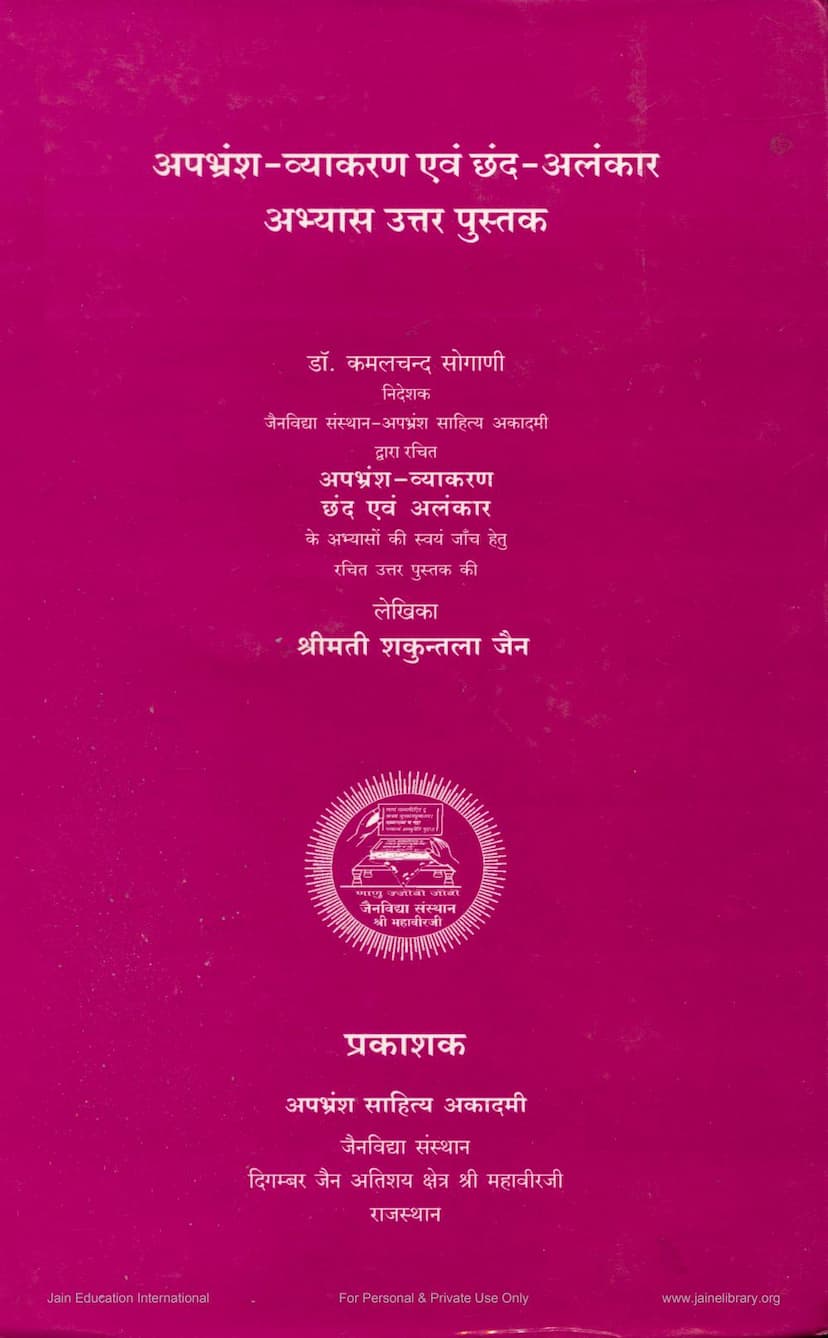Apbhramsa Vyakaran Evam Chand Alankar Abhyas Uttar Pustak
Added to library: September 1, 2025
Loading image...

Summary
This document is the answer key for a workbook titled "Apabhramsa Grammar and Prosody-Ornamentation Practice Answer Book" (अपभ्रंश-व्याकरण एवं छंद-अलंकार अभ्यास उत्तर पुस्तक).
Here's a breakdown of its content and purpose:
- Authors: Dr. Kamalchand Sogani (credited with the original Apabhramsa Grammar, Prosody, and Ornamentation text) and Mrs. Shakuntala Jain (credited with creating this answer book).
- Publisher: Apabhramsa Sahitya Academy, Jainvidya Sansthan, Shri Mahavirji, Rajasthan.
- Purpose: The book serves as an answer key for students studying Apabhramsa grammar, particularly for exercises related to Sandhi (joining of sounds), Samasa (compounds), and Karaka (case relationships), as well as for prosody (Chanda) and poetic ornamentation (Alankara). It allows students to self-check their answers and understand the corrections.
- Context: The preface highlights the importance of studying Apabhramsa, calling it the "mother" of Indian Arya languages, including Hindi. It explains that Apabhramsa was the spoken language across North India from the 7th to 13th centuries. The Jainvidya Sansthan at Shri Mahavirji aims to promote Apabhramsa studies. The answer book is published in conjunction with other Apabhramsa study materials.
- Content Structure: The book is divided into sections for:
- Apabhramsa Grammar (अपभ्रंश-व्याकरण):
- Sandhi Prayog ke Udaharan (Examples of Sandhi usage) - This section provides Apabhramsa words from various literary works (like Paumacariu, Mahapurana, Jambusamicariu, etc.), shows their breakdown (sandhi viched), and explains the specific Sandhi rule applied.
- Samasa Prayog ke Udaharan (Examples of Samasa usage) - Similar to Sandhi, this section lists Apabhramsa compound words, breaks them down into their constituent parts, and identifies the type of Samasa (e.g., Tatpurusha, Dvanda, Karmadharaya, Digú).
- Karaka Abhyas (Case Exercises) - This section presents exercises related to the different case endings (Prathama to Saptami Vibhakti) in Apabhramsa. For each sentence fragment, it provides the Apabhramsa word, its case, and the relevant grammatical rule explaining why that case is used.
- Prosody and Ornamentation (छंद एवं अलंकार):
- Prosody (Chanda) - Khand 1 & 2 (छन्द (खण्ड 1) & छन्द (खण्ड 2)): These sections present exercises related to identifying and defining various Apabhramsa prosodic meters (Chanda). For each meter, the "Lakshana" (definition/characteristics) is provided, including the number of verses, syllable count per verse, and specific metrical patterns or ending feet.
- Ornamentation (Alankara): This section provides definitions and explanations of various figures of speech (Alankara) used in Apabhramsa poetry, such as Upama (simile), Utpreksha (hyperbole), Anupraas (alliteration), Yamaka (rhyme), Virodhabhasa (paradox), Bhavanam (cause and effect inversion), Sandeha (doubt), Bhrantiman (delusion), and Shlesh (pun).
- Apabhramsa Grammar (अपभ्रंश-व्याकरण):
In essence, this book is a pedagogical tool designed to assist students in mastering the grammatical structures and poetic forms of the Apabhramsa language through practical exercises and their verified solutions.